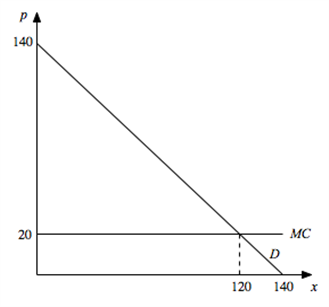Positive analysis:
A. leads to the best solutions.
B. is the best way to analyze a policy.
C. examines if the policy actually accomplished its goals.
D. is the only way to analyze a policy.
Answer: C
You might also like to view...
Suppose a single firm has constant marginal cost and faced the demand curve 
b. Suppose two firms with the same marginal cost as the monopolist operated in this market instead. Suppose quantity is the strategic variable and the two firms simultaneously choose quantity. On a graph with firm 1's output on the horizontal and firm 2's output on the vertical, illustrate firm 2's best response function with numerical labels for each intercept. c. Add firm 1's best response function and determine the Nash equilibrium quantities. d. What's the equilibrium price resulting from the quantities you determined in (c)? e. What would be the equilibrium price if the strategic variable for the firms were price instead? What will be an ideal response?
Which of the following statements is the MOST accurate? In general, under the monetary approach to the exchange rate
A) the interest rate is not independent of the money supply growth rate in the short run. B) the interest rate is independent of the money supply growth rate in the long run. C) the interest rate is not independent of the money supply growth rate in the long run, but independent in the short run. D) the interest rate is not independent of the money supply growth rate in the long run. E) the interest rate is a factor of the money supply growth rate only in the short term.
When a trading opportunity is presented to a heterogeneous group of potential traders, those who accept it will be often
A. smarter, on average, than those who do not accept it than those who do not. B. better, on average, than those who do not accept it. C. worse-on the average, than those who do not accept it. D. no different than those who do not.
Consider the model: log(wage) = 
female +
exper +
class="Wirisformula" data-wiris-created="true" src="@@PLUGINFILE@@/ppg__cognero__Ch_07_Multiple_Regression_Analysis_with_Qualitative_Information__media__5dc5a813-d9ab-40f1-aeec-01f10346ab72.PNG" style="vertical-align:middle;" />female * exper + u, where exper is the years of work experience, and female is a dummy variable (1 if the person is female, and 0 otherwise). Which of the following measures the difference in the return of experience between men and women?
A.
B. +
C. +
+
D. +